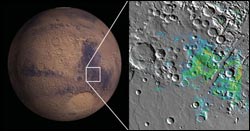A Young Mars Most Likely to Support Life, New Mineral History Shows

<b>A Martian Mineral History</b> <br>The large dark area right of center on the hemisphere view of Mars is Syrtis Major. The map shows the presence of water-bearing clay minerals identified by OMEGA data. Blue indicates small amounts and orange-red indicates large amounts.
An international team of scientists, including Brown University geologist John Mustard, has created the most comprehensive mineral record of Mars to date. Using data from the European Space Agency’s Mars Express mission, the record shows three distinct geological eras on the Red Planet, with the earliest marked by the presence of water. Results are published in Science.
Mars started out relatively wet and temperate, underwent a major climate shift, and evolved into a cold, dry place strewn with acidic rock – less than ideal conditions for supporting life.
This is the finding of an international team of scientists who have created the most comprehensive mineral history of Mars, a history closely linked to the presence of liquid water on the planet. According to the mineral record, created with Mars Express mission data and detailed in Science, Mars would only have been hospitable to life in its infancy.
“Starting about 3.5 billion years ago, conditions on Mars became increasingly dry and acidic – not a pleasant place for any form of life, even a microbe,” said John Mustard, a Brown University geologist and a primary author of the Science paper.
If any living organisms had formed on Mars, that evidence would likely be found in clay-rich rocks and soil north of the Syrtis Major volcanic plateau, in Nili Fossae and in the Marwth Vallis Regions, the team reports.
These areas make compelling targets for future lander missions, according to Mustard, a co-investigator on the Mars Express and Mars Reconnaissance Orbiter missions. In the meantime, the Compact Reconnaissance Imaging Spectrometer for Mars, or CRISM, aboard the Mars Reconnaissance Orbiter, will in September begin beaming mineralogical data on these clay-rich regions. The images will be 20 times more precise compared with those captured by Mars Express.
“I’m eager to get the CRISM data and explore the deposits found by OMEGA, as well as discover new sites and minerals,” Mustard said. “OMEGA shows that some of the most interesting sites are small – and CRISM is designed to find and characterize small deposits.”
Jean-Pierre Bibring, an astrophysicist from the University of Paris, led the team of scientists from France, Italy, Russia, Germany and the United States. The investigators pieced together the mineral history using data from Mars Express, a mission launched by the European Space Agency. An instrument aboard the spacecraft dubbed OMEGA – short for Observatoire pour la Minéralogie, l’Eau, les Glaces et l’Activité – determines mineral composition from visible and infrared light reflected from the Red Planet’s surface. The team used two years worth of data from OMEGA, which has mapped more than 90 percent of the planet’s surface.
The team found three distinct geological eras on Mars:
- The first era lasted from the birth of Mars, about 4.6 billion years ago, until about 4 billion years ago. The oldest rock – exposed by erosion, impact or faulting – shows the presence of clay minerals. These minerals, such as chamosite and nontronite, need abundant water, moderate temperatures and low acidity to form.
- The second era lasted from between 4 and 3.5 billion years ago. Minerals made during this era, such as gypsum and grey hematite, were found in Meridiani and in Valles Marineris. These rocks, traced by sulfates, mark a dramatic shift from a moist and alkaline environment to a dry, acidic one. The shift, the team concludes, was likely caused by massive volcanic eruptions that spewed sulfur into the atmosphere, which then rained back down on the planet’s surface.
- The third era began between 3.2 billion and 3.5 billion years ago and continues to the present. Minerals during this period were not formed with, or altered by, liquid water. These iron-rich minerals, dominated by ferric oxides, were found across most of the planet and reflect the cold, dry conditions that persist on Mars.
The team’s analysis led them to draw an intriguing conclusion: Liquid water didn’t make the Red Planet red. Instead, the team states, Mars most likely gets its glow from tiny grains of red hematite or possibly maghemite, both riddled with iron.
The Centre National d’Etudes Spatiales, Agenzia Spatiale Italiana and the Russian Space Agency funded the OMEGA instrument. In the United States, NASA supported OMEGA data analysis.
Media Contact
More Information:
http://www.brown.eduAll latest news from the category: Earth Sciences
Earth Sciences (also referred to as Geosciences), which deals with basic issues surrounding our planet, plays a vital role in the area of energy and raw materials supply.
Earth Sciences comprises subjects such as geology, geography, geological informatics, paleontology, mineralogy, petrography, crystallography, geophysics, geodesy, glaciology, cartography, photogrammetry, meteorology and seismology, early-warning systems, earthquake research and polar research.
Newest articles

High-energy-density aqueous battery based on halogen multi-electron transfer
Traditional non-aqueous lithium-ion batteries have a high energy density, but their safety is compromised due to the flammable organic electrolytes they utilize. Aqueous batteries use water as the solvent for…

First-ever combined heart pump and pig kidney transplant
…gives new hope to patient with terminal illness. Surgeons at NYU Langone Health performed the first-ever combined mechanical heart pump and gene-edited pig kidney transplant surgery in a 54-year-old woman…

Biophysics: Testing how well biomarkers work
LMU researchers have developed a method to determine how reliably target proteins can be labeled using super-resolution fluorescence microscopy. Modern microscopy techniques make it possible to examine the inner workings…





















